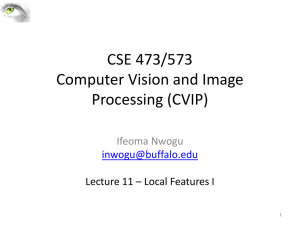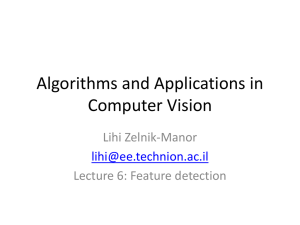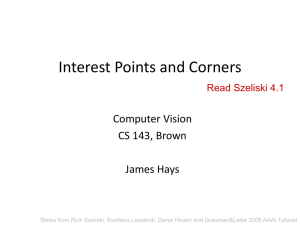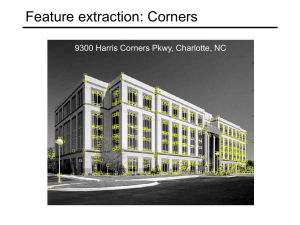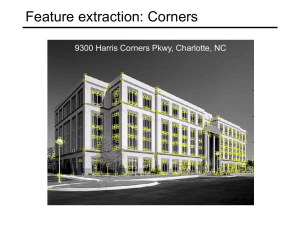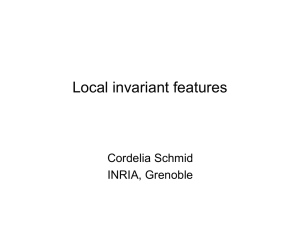ppt
advertisement
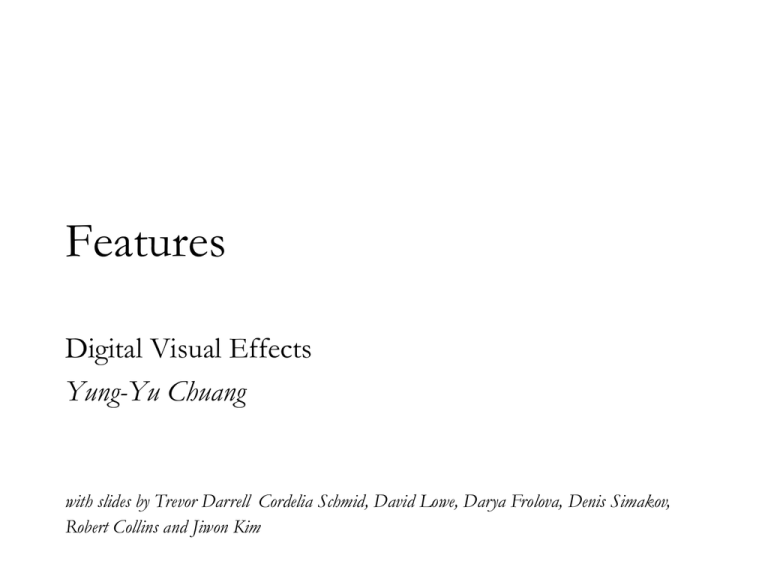
Features
Digital Visual Effects
Yung-Yu Chuang
with slides by Trevor Darrell Cordelia Schmid, David Lowe, Darya Frolova, Denis Simakov,
Robert Collins and Jiwon Kim
Outline
•
•
•
•
•
Features
Harris corner detector
SIFT
Extensions
Applications
Features
Features
• Also known as interesting points, salient points
or keypoints. Points that you can easily point
out their correspondences in multiple images
using only local information.
?
Desired properties for features
• Distinctive: a single feature can be correctly
matched with high probability.
• Invariant: invariant to scale, rotation, affine,
illumination and noise for robust matching
across a substantial range of affine distortion,
viewpoint change and so on. That is, it is
repeatable.
Applications
•
•
•
•
•
Object or scene recognition
Structure from motion
Stereo
Motion tracking
…
Components
• Feature detection locates where they are
• Feature description describes what they are
• Feature matching decides whether two are the
same one
Harris corner detector
Moravec corner detector (1980)
• We should easily recognize the point by looking
through a small window
• Shifting a window in any direction should give a
large change in intensity
Moravec corner detector
flat
Moravec corner detector
flat
Moravec corner detector
flat
edge
Moravec corner detector
flat
edge
corner
isolated point
Moravec corner detector
Change of intensity for the shift [u,v]:
E(u, v) w( x, y)I ( x u, y v) I ( x, y)
2
x, y
window
function
shifted
intensity
intensity
Four shifts: (u,v) = (1,0), (1,1), (0,1), (-1, 1)
Look for local maxima in min{E}
Problems of Moravec detector
• Noisy response due to a binary window function
• Only a set of shifts at every 45 degree is
considered
• Only minimum of E is taken into account
Harris corner detector (1988) solves these
problems.
Harris corner detector
Noisy response due to a binary window function
Use a Gaussian function
Harris corner detector
Only a set of shifts at every 45 degree is considered
Consider all small shifts by Taylor’s expansion
Harris corner detector
Only a set of shifts at every 45 degree is considered
Consider all small shifts by Taylor’s expansion
E(u, v) w( x, y)I ( x u, y v) I ( x, y)
2
x, y
w( x, y ) I x u I y v O(u , v )
x, y
E (u , v) Au 2 2Cuv Bv 2
A w( x, y ) I x2 ( x, y )
x, y
B w( x, y ) I y2 ( x, y )
x, y
C w( x, y ) I x ( x, y ) I y ( x, y )
x, y
2
2
2
Harris corner detector
Equivalently, for small shifts [u,v] we have a bilinear
approximation:
u
E (u, v) u v M
v
, where M is a 22 matrix computed from image derivatives:
I x2
M w( x, y )
x, y
I x I y
IxI y
2
I y
Harris corner detector (matrix form)
E (u)
2
w
(
x
)
|
I
(
x
u
)
I
(
x
)
|
0
0
0
x 0 W ( p )
| I ( x 0 u ) I ( x 0 ) |2
I
I 0
u I 0
x
T
I
u
x
T
2
I I
u
u
x x
uT Mu
T
T
2
Harris corner detector
Only minimum of E is taken into account
A new corner measurement by investigating the
shape of the error function
uT Mu represents a quadratic function; Thus, we
can analyze E’s shape by looking at the property
of M
Harris corner detector
High-level idea: what shape of the error function
will we prefer for features?
100
100
100
80
80
80
60
60
60
40
40
40
20
20
20
0
0
0
10
5
0 0
flat
2
4
6
8
10
12
10
5
0 0
2
edge
4
6
8
10
12
10
5
0 0
2
4
corner
6
8
10
12
Quadratic forms
• Quadratic form (homogeneous polynomial of
degree two) of n variables xi
• Examples
=
Symmetric matrices
• Quadratic forms can be represented by a real
symmetric matrix A where
Eigenvalues of symmetric matrices
Brad Osgood
Eigenvectors of symmetric matrices
Eigenvectors of symmetric matrices
x T Ax
x TQ Λ Q T x
T
QTx Λ QTx
y Λy
2 q2
z z 1
T
1 q1
T
Λ y
1
2
Λ y
zTz
T
1
2
xT x 1
Harris corner detector
Intensity change in shifting window: eigenvalue analysis
u
E (u, v) u, v M
v
Ellipse E(u,v) = const
1, 2 – eigenvalues of M
direction of the
fastest change
(max)-1/2
(min)-1/2
direction of the
slowest change
Visualize quadratic functions
1 0 1 0 1 0 1 0
A
0 1 0 1 0 1 0 1
T
Visualize quadratic functions
4 0 1 0 4 0 1 0
A
0 1 0 1 0 1 0 1
T
Visualize quadratic functions
3.25 1.30 0.50 0.87 1 0 0.50 0.87
A
0 4 0.87 0.50
1
.
30
1
.
75
0
.
87
0
.
50
T
Visualize quadratic functions
7.75 3.90 0.50 0.87 1 0 0.50 0.87
A
0 10 0.87 0.50
3
.
90
3
.
25
0
.
87
0
.
50
T
Harris corner detector
Classification of
image points
using eigenvalues
of M:
2 edge
2 >> 1
Corner
1 and 2 are large,
1 ~ 2 ;
E increases in all
directions
1 and 2 are small;
E is almost constant
in all directions
flat
edge
1 >> 2
1
Harris corner detector
a00 a11 (a00 a11 ) 2 4a10 a01 Only for reference,
you do not need
2
them to compute R
Measure of corner response:
R detM k traceM
2
det M 12
traceM 1 2
(k – empirical constant, k = 0.04-0.06)
Harris corner detector
Another view
Another view
Another view
Summary of Harris detector
1. Compute x and y derivatives of image
I x G I
x
I y G I
y
2. Compute products of derivatives at every pixel
I x2 I x I x
I y2 I y I y
I xy I x I y
3. Compute the sums of the products of
derivatives at each pixel
S x2 G ' I x2
S y 2 G ' I y 2
S xy G ' I xy
Summary of Harris detector
4. Define the matrix at each pixel
S x 2 ( x, y ) S xy ( x, y )
M ( x, y )
S xy ( x, y ) S y 2 ( x, y )
5. Compute the response of the detector at each
pixel
2
R det M k traceM
6. Threshold on value of R; compute nonmax
suppression.
Harris corner detector (input)
Corner response R
Threshold on R
Local maximum of R
Harris corner detector
Harris detector: summary
• Average intensity change in direction [u,v] can be
expressed as a bilinear form:
u
E (u, v) u, v M
v
• Describe a point in terms of eigenvalues of M:
measure of corner response
R 12 k 1 2
2
• A good (corner) point should have a large intensity
change in all directions, i.e. R should be large
positive
Now we know where features are
• But, how to match them?
• What is the descriptor for a feature? The
simplest solution is the intensities of its spatial
neighbors. This might not be robust to
brightness change or small shift/rotation.
(
1
2
3
1
2
3
4
5
6
7
8
9
4
5
6
7
8
9
)
Harris detector: some properties
• Partial invariance to affine intensity change
Only derivatives are used =>
invariance to intensity shift I I + b
Intensity scale: I a I
R
R
threshold
x (image coordinate)
x (image coordinate)
Harris Detector: Some Properties
• Rotation invariance
Ellipse rotates but its shape (i.e. eigenvalues) remains
the same
Corner response R is invariant to image rotation
Harris Detector is rotation invariant
Repeatability rate:
# correspondences
# possible correspondences
Harris Detector: Some Properties
• But: not invariant to image scale!
All points will be
classified as edges
Corner !
Harris detector: some properties
• Quality of Harris detector for different scale
changes
Repeatability rate:
# correspondences
# possible correspondences
Scale invariant detection
• Consider regions (e.g. circles) of different sizes
around a point
• Regions of corresponding sizes will look the
same in both images
Scale invariant detection
• The problem: how do we choose corresponding
circles independently in each image?
• Aperture problem
SIFT
(Scale Invariant Feature Transform)
SIFT
• SIFT is an carefully designed procedure with
empirically determined parameters for the
invariant and distinctive features.
SIFT stages:
•
•
•
•
Scale-space extrema detection
Keypoint localization
Orientation assignment
Keypoint descriptor
detector
descriptor
()
local descriptor
A 500x500 image gives about 2000 features
1. Detection of scale-space extrema
• For scale invariance, search for stable features
across all possible scales using a continuous
function of scale, scale space.
• SIFT uses DoG filter for scale space because it is
efficient and as stable as scale-normalized
Laplacian of Gaussian.
DoG filtering
Convolution with a variable-scale Gaussian
Difference-of-Gaussian (DoG) filter
Convolution with the DoG filter
Scale space
doubles for
the next octave
K=2(1/s)
Dividing into octave is for efficiency only.
Detection of scale-space extrema
Keypoint localization
X is selected if it is larger or smaller than all 26 neighbors
Decide scale sampling frequency
• It is impossible to sample the whole space,
tradeoff efficiency with completeness.
• Decide the best sampling frequency by
experimenting on 32 real image subject to
synthetic transformations. (rotation, scaling,
affine stretch, brightness and contrast change,
adding noise…)
Decide scale sampling frequency
Decide scale sampling frequency
for detector,
repeatability
for descriptor,
distinctiveness
s=3 is the best, for larger s, too many unstable features
Pre-smoothing
=1.6, plus a double expansion
Scale invariance
2. Accurate keypoint localization
• Reject points with low contrast (flat) and
poorly localized along an edge (edge)
• Fit a 3D quadratic function for sub-pixel
maxima
6
5
1
-1
0
+1
2. Accurate keypoint localization
• Reject points with low contrast (flat) and
poorly localized along an edge (edge)
• Fit a 3D quadratic function for sub-pixel
1
maxima
f ' ' (0)
6
f ( x) f (0) f ' (0) x
3
6
5
f ( x) 6 2 x
2
6 2
x 6 2 x 3x 2
2
1
f ' ( x) 2 6 x 0
3
2
1
1
1
f ( xˆ ) 6 2 3 6
3
3
3
xˆ
1
-1
x2
0 1
3
+1
2. Accurate keypoint localization
• Taylor series of several variables
• Two variables
1 2 f 2
2 f
2 f 2
y
x 2
xy
y
xy
yy
2 xx
2 f
2 f
x
x
0 f f x 1
x
x
x
y
f f
x y 2
2
f y
f
y
0 x y y 2
xy yy
T
2
f
1 f
f x f 0
x xT 2 x
x
2
x
f
f
f ( x, y) f (0,0) x
y
x
Accurate keypoint localization
• Taylor expansion in a matrix form, x is a vector,
f maps x to a scalar
Hessian matrix
(often symmetric)
f
gradient
x1
f
x
1
f
x
n
2 f
2
x
1
2 f
x2x1
2 f
x x
n 1
2 f
x1x2
2 f
x22
2 f
xn x2
2 f
x1xn
2 f
x2xn
2 f
2
xn
2D illustration
2D example
-17 -1
-1
-9
7
7
-9
7
7
Derivation of matrix form
h(x) g x
T
h
x
Derivation of matrix form
h(x) g x
T
g1
n
x1
g n
x
n
gi xi
i 1
h
g
x1 1
h
g
x h
g
n
x
n
Derivation of matrix form
h(x) x Ax
T
h
x
Derivation of matrix form
h(x) x Ax x1
T
n
n
aij xi x j
a11 a1n x1
xn
a
x
a
nn n
n1
i 1 j 1
n
n
h
ai1 xi a1 j x j
x1 i 1
j 1
h
T
A x Ax
n
x h n
T
a
x
a
x
in
i
nj
j
(
A
A)x
x
j 1
n i 1
Derivation of matrix form
2
2 T
2
f f 1 f f
f f
2 x
2 x
2
x x 2 x
x
x x
Accurate keypoint localization
• x is a 3-vector
• Change sample point if offset is larger than 0.5
• Throw out low contrast (<0.03)
Accurate keypoint localization
• Throw out low contrast | D(xˆ ) | 0.03
D
1 T 2D
D(xˆ ) D
xˆ xˆ
xˆ
2
x
2
x
T
T
1
2
2
D
1 D D D D D
D
xˆ 2
2
2
x
2 x
x x x
x
T
D
1 D D
xˆ
x
2 x x 2
T
D
1
2
T
2
T
1
D
1 D D D
xˆ
x
2 x x 2 x
T
T
D
1 D
D
xˆ
(xˆ )
x
2 x
T
1 D
D
xˆ
2 x
T
D
T
2
1
D D D
x 2 x 2 x
2
2
Eliminating edge responses
Hessian matrix at keypoint location
Let
Keep the points with
r=10
Maxima in D
Remove low contrast and edges
Keypoint detector
233x89
832 extrema
729 after contrast filtering
536 after curvature filtering
3. Orientation assignment
• By assigning a consistent orientation, the
keypoint descriptor can be orientation invariant.
• For a keypoint, L is the Gaussian-smoothed
image with the closest scale,
(Lx, Ly)
m
θ
orientation histogram (36 bins)
Orientation assignment
Orientation assignment
Orientation assignment
Orientation assignment
σ=1.5*scale of
the keypoint
Orientation assignment
Orientation assignment
Orientation assignment
accurate peak position
is determined by fitting
Orientation assignment
36-bin orientation histogram over 360°,
weighted by m and 1.5*scale falloff
Peak is the orientation
Local peak within 80% creates multiple
orientations
About 15% has multiple orientations
and they contribute a lot to stability
SIFT descriptor
4. Local image descriptor
• Thresholded image gradients are sampled over 16x16
array of locations in scale space
• Create array of orientation histograms (w.r.t. key
orientation)
• 8 orientations x 4x4 histogram array = 128 dimensions
• Normalized, clip values larger than 0.2, renormalize
σ=0.5*width
Why 4x4x8?
Sensitivity to affine change
Feature matching
• for a feature x, he found the closest feature x1
and the second closest feature x2. If the
distance ratio of d(x, x1) and d(x, x1) is smaller
than 0.8, then it is accepted as a match.
SIFT flow
Maxima in D
Remove low contrast
Remove edges
SIFT descriptor
Estimated rotation
• Computed affine transformation from rotated
image to original image:
0.7060 -0.7052 128.4230
0.7057 0.7100 -128.9491
0
0
1.0000
• Actual transformation from rotated image to
original image:
0.7071 -0.7071 128.6934
0.7071 0.7071 -128.6934
0
0
1.0000
SIFT extensions
PCA
PCA-SIFT
• Only change step 4
• Pre-compute an eigen-space for local gradient
patches of size 41x41
• 2x39x39=3042 elements
• Only keep 20 components
• A more compact descriptor
GLOH (Gradient location-orientation histogram)
SIFT
17 location bins
16 orientation bins
Analyze the 17x16=272-d
eigen-space, keep 128 components
SIFT is still considered the best.
Multi-Scale Oriented Patches
• Simpler than SIFT. Designed for image matching.
[Brown, Szeliski, Winder, CVPR’2005]
• Feature detector
– Multi-scale Harris corners
– Orientation from blurred gradient
– Geometrically invariant to rotation
• Feature descriptor
– Bias/gain normalized sampling of local patch (8x8)
– Photometrically invariant to affine changes in
intensity
Multi-Scale Harris corner detector
s2
• Image stitching is mostly concerned with
matching images that have the same scale, so
sub-octave pyramid might not be necessary.
Multi-Scale Harris corner detector
smoother version of gradients
Corner detection function:
Pick local maxima of 3x3 and larger than 10
Keypoint detection function
Experiments show roughly
the same performance.
Non-maximal suppression
• Restrict the maximal number of interest points,
but also want them spatially well distributed
• Only retain maximums in a neighborhood of
radius r.
• Sort them by strength, decreasing r from
infinity until the number of keypoints (500) is
satisfied.
Non-maximal suppression
Sub-pixel refinement
Orientation assignment
• Orientation = blurred gradient
Descriptor Vector
• Rotation Invariant Frame
– Scale-space position (x, y, s) + orientation ()
MSOP descriptor vector
• 8x8 oriented patch sampled at 5 x scale. See TR
for details.
• Sampled from
with
spacing=5
8 pixels
MSOP descriptor vector
• 8x8 oriented patch sampled at 5 x scale. See TR
for details.
• Bias/gain normalisation: I’ = (I – )/
• Wavelet transform
8 pixels
Detections at multiple scales
Summary
•
•
•
•
Multi-scale Harris corner detector
Sub-pixel refinement
Orientation assignment by gradients
Blurred intensity patch as descriptor
Feature matching
• Exhaustive search
– for each feature in one image, look at all the other
features in the other image(s)
• Hashing
– compute a short descriptor from each feature vector,
or hash longer descriptors (randomly)
• Nearest neighbor techniques
– k-trees and their variants (Best Bin First)
Wavelet-based hashing
• Compute a short (3-vector) descriptor from an
8x8 patch using a Haar “wavelet”
• Quantize each value into 10 (overlapping) bins
(103 total entries)
• [Brown, Szeliski, Winder, CVPR’2005]
Nearest neighbor techniques
• k-D tree
and
• Best Bin
First
(BBF)
Indexing Without Invariants in 3D Object Recognition, Beis and Lowe, PAMI’99
Applications
Recognition
SIFT Features
3D object recognition
3D object recognition
Office of the past
Images from PDF
Video of desk
Internal representation
Track &
recognize
Scene Graph
Desk
Desk
T
T+1
Image retrieval
…
> 5000
images
change in viewing angle
Image retrieval
22 correct matches
Image retrieval
…
> 5000
images
change in viewing angle
+ scale change
Robot location
Robotics: Sony Aibo
SIFT is used for
Recognizing
charging station
Communicating
with visual cards
Teaching object
recognition
soccer
Structure from Motion
• The SFM Problem
– Reconstruct scene geometry and camera motion
from two or more images
Track
2D Features
Estimate
3D
Optimize
(Bundle Adjust)
SFM Pipeline
Fit Surfaces
Structure from Motion
Poor mesh
Good mesh
Augmented reality
Automatic image stitching
Automatic image stitching
Automatic image stitching
Automatic image stitching
Automatic image stitching
Reference
• Chris Harris, Mike Stephens, A Combined Corner and Edge Detector,
4th Alvey Vision Conference, 1988, pp147-151.
• David G. Lowe, Distinctive Image Features from Scale-Invariant
Keypoints, International Journal of Computer Vision, 60(2), 2004,
pp91-110.
• Yan Ke, Rahul Sukthankar, PCA-SIFT: A More Distinctive
Representation for Local Image Descriptors, CVPR 2004.
• Krystian Mikolajczyk, Cordelia Schmid, A performance evaluation
of local descriptors, Submitted to PAMI, 2004.
• SIFT Keypoint Detector, David Lowe.
• Matlab SIFT Tutorial, University of Toronto.
